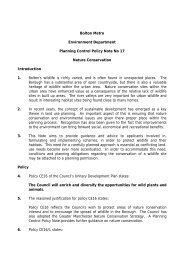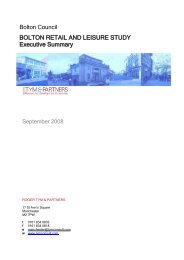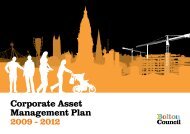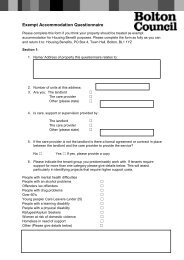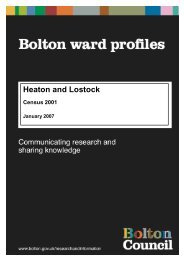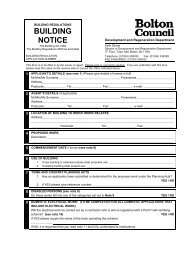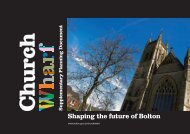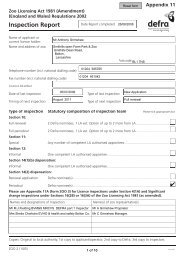Town Hall Conservation Area - Bolton Metropolitan Borough Council
Town Hall Conservation Area - Bolton Metropolitan Borough Council
Town Hall Conservation Area - Bolton Metropolitan Borough Council
You also want an ePaper? Increase the reach of your titles
YUMPU automatically turns print PDFs into web optimized ePapers that Google loves.
Mans Crescent. The frontages around the square were re-developed for retail or office<br />
use in the 20 th century, and original 19 th century buildings are now rare in this area.<br />
The scale of the majority of buildings in the conservation area is fairly uniform, with<br />
buildings generally no more than 3 or 4 storeys high, allowing the large volume and tall<br />
clock tower of the <strong>Town</strong> <strong>Hall</strong> to visually dominate the area, and indeed much of the<br />
central part of the town. Longer views of the <strong>Town</strong> <strong>Hall</strong> are important from points around<br />
the edge of the town centre, including from Queens Park and gateways into the town<br />
such as Tonge Road, Chorley Old Road and Bury Road.<br />
Within the town centre, the grid street pattern and openness of Victoria Square allows for<br />
a mixture of open and framed views. Views of the <strong>Town</strong> <strong>Hall</strong> across the Square are very<br />
significant, although in summer trees partly obscure the views. Views either side of the<br />
<strong>Town</strong> <strong>Hall</strong> are important towards Le Mans Crescent, and also along Queen Street and<br />
Cheadle Square of the rear of the Crescent, where the high quality of the Le Mans<br />
Crescent buildings extends to the rear elevation. Longer north-south views are possible<br />
along Oxford Street and Newport Street. Views along side streets are terminated by the<br />
mass of the <strong>Town</strong> <strong>Hall</strong>, creating some dramatic framed views of the building.<br />
Most buildings are faced in stone, reflecting the high status of the civic buildings and<br />
also the post-war use of stone cladding. A few buildings have been rendered or painted<br />
on Oxford Street. Roofs are slate or in a variety of sheet cladding materials such as<br />
copper.<br />
The fairly coarse grain of the townscape is the result of the re-development of many<br />
sites with large buildings from the early 20 th century, often occupying whole blocks in<br />
contrast to the finer grain of early 19 th century streets in <strong>Bolton</strong>. Some of this redevelopment<br />
has obscured the historic street pattern; the rear of the <strong>Town</strong> <strong>Hall</strong> was built<br />
over Howell Croft and the west end of Exchange Street was built over at first floor level<br />
by part of the Crompton Place development. Victoria Square is the town centre‟s most<br />
important open space, with a secondary open space west of Le Mans Crescent;<br />
however, this works less well and there may scope for development on part of this area.<br />
Historic street surfaces are important to the character of the conservation area,<br />
particularly on Le Mans Crescent, Howell Croft North and Queen Street, where granite<br />
setts and stone paving have been retained. Elsewhere, streets are surfaced in<br />
tarmacadam with concrete paving. Victoria Square has been re-laid with a combination<br />
of concrete setts and stone paving. with contemporary lighting and seating. There are<br />
some good examples of historic street lamp columns on Cheadle Square. Except for<br />
Black Horse Street and Ashburner Street, vehicular traffic is light due to the large<br />
pedestrianised areas, which are busy with people.<br />
4.0 Assessing Special Interest:<br />
4.1 Location and setting<br />
The <strong>Town</strong> <strong>Hall</strong> conservation area is located on the east side of the town centre, on a<br />
plateau of land defined by the River Croal to the north and east. <strong>Bolton</strong> developed at the<br />
junction of several small rivers, which are tributaries of the River Irwell. The underlying<br />
geology is Carboniferous Sandstone with coal measures, overlain by sands and gravels.<br />
July 2008 4




